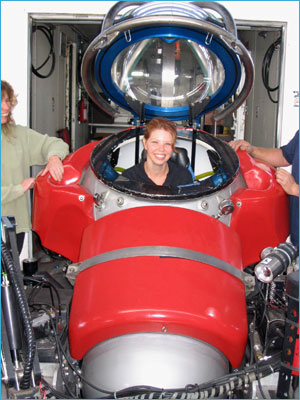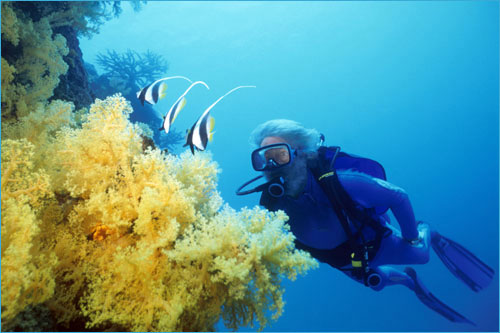|
Education and Outreach
Watershed Education Initiative
Broadens Ocean Literacy
Training Tomorrow’s Leaders in Science and Technology
 |
|
Program staff help students learn about sanctuary science and technology. (Photo: Jennifer Stock, Cordell Bank National Marine Sanctuary)
|
Preparing tomorrow’s leaders begins with educating today’s students. Hands-on educational programs help reach that end. Helping students learn how to monitor rocky intertidal and sandy beach ecosystems, and letting them work with marine technology, such as remotely operated vehicles (ROV), are some of the ways program staff help students focus on science and technology. These educational experiences are critical for maintaining a healthy coastal economy and our world leadership in science and technology. Throughout the sanctuary system, the program's education team held nine ROV workshops for 127 educators. More than 500 students built and/or operated ROVs from their classrooms or local pool giving students a hands-on look into the undersea world and the technology used to illuminate that world. Program staff also collaborated with various partners to host three regional student ROV competitions that involved more than 200 students about marine technology and science.
In California, the Bay Watershed Education and Training program, commonly referred to as B-WET, expanded from Monterey to the San Francisco Bay and Santa Barbara Channel regions. First established in 2003 in the Chesapeake Bay region, the program provides organizations with funds to support environmental education for teachers, students, and communities throughout the watershed. B-WET funded programs provide meaningful outdoor watershed experiences to enhance students’ environmental awareness and appreciation.
Innovative Marine Portal Enhances Ocean Education
OceansLive.org is a new marine science portal that blends live interactive video from research expeditions and educational lessons about our marine environment. In June, the public followed an expedition to the USS Monitor. The live coverage had more than 12,000 hits per day with viewers asking questions to the scientists. Using similar technology, Internet users got a live look at the Frank A. Palmer, a New England vessel that sank in 1902. This type of technology allows all Americans to experience the wonders of our national marine sanctuaries.
Films Educate Millions About Sanctuary System
The power of film cannot be overstated, particularly when the film’s message is one of hope. In a world where the health of our oceans is in constant peril, Jean-Michel Cousteau’s voice is an important one. His latest call for ocean stewardship is his nationally aired PBS co-production America’s Underwater Treasures, a journey through all 13 national marine sanctuaries. The film not only captures the story of each sanctuary, but sounds a call to take care of our marine ecosystems. In Cousteau’s own words, “In part at risk and in part still pristine, the national marine sanctuaries are their own proof that they must be guarded for future generations.” Film festivals also educate people in an entertaining fashion. Thousands in California and in Savannah, Ga., saw films highlighting marine life on reefs, oceanography and coastal cultures.
|
|
|
Jean-Michel Cousteau during filming of America’s Underwater Treasures. (Photo: Tom Ordway, Ocean Futures and KQED)
|
New Visitor Centers Open in Sanctuary Communities
One of the best ways for people to learn about their national marine sanctuaries is by visiting discovery centers, museums or aquaria that offer the public personal connections with the marine environment. The Gloucester Maritime Heritage Center in Massachusetts features dynamic new exhibits showcasing the marine life and shipwrecks of Stellwagen Bank National Marine Sanctuary, and the Coastal Discovery Center in San Simeon, Calif., highlights the marine ecosystems of Monterey Bay National Marine Sanctuary and California’s Central Coast. These centers are popular and yearly reach thousands of people from the east coast to Hawaii.
|






